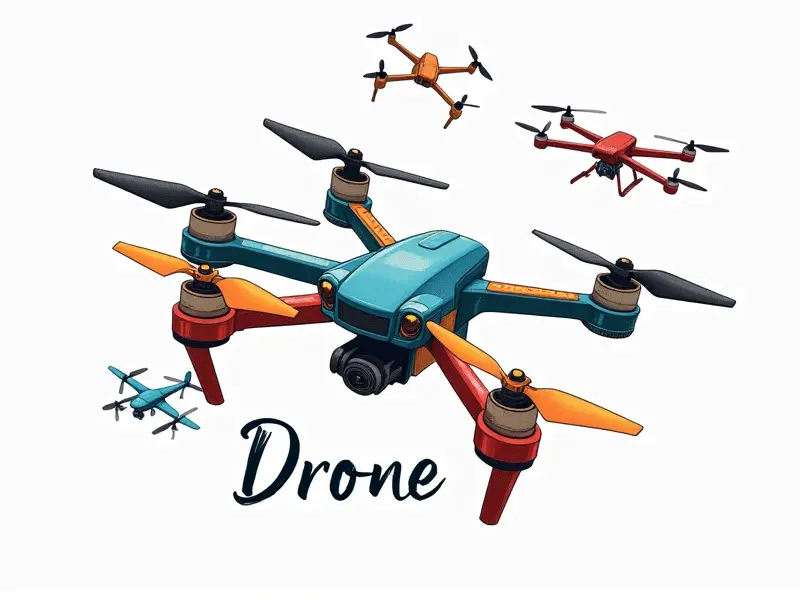RC airplane propellers types

Guide to Selecting Optimal Propellers for RC Planes
Selecting the right propeller is crucial for optimizing your remote control (RC) airplane's performance. The propeller interacts directly with the engine and air, affecting speed, efficiency, and stability. This guide will walk you through understanding different types of propellers, their materials, pitches, sizes, and how to fine-tune them for peak performance.
Exploring CW and CCW Propeller Blades
The direction in which a propeller rotates is critical to its function. Clockwise (CW) and counterclockwise (CCW) propellers are designed specifically for different engine setups:
- CW Propellers: Typically used with engines that rotate clockwise when viewed from the front.
- CCW Propellers: Designed to work with engines rotating counterclockwise.
The direction of rotation affects thrust distribution and overall aerodynamics, making it essential to match your propeller type with your engine's specifications.
Propeller Material Choices: Plastic vs. Wood vs. Carbon Fiber
Choosing the right material for your RC airplane propellers is crucial for performance and durability:
- Plastic Propellers: Lightweight, inexpensive, and easy to replace.
- Wooden Propellers: Durable, balanced, and offer better aerodynamics compared to plastic.
- Carbon Fiber Propellers: Extremely lightweight yet strong, providing high performance but at a higher cost.
The material you choose will depend on your budget, desired performance level, and maintenance requirements.
Maximizing Efficiency with the Right Propeller Pitch
The pitch of an RC propeller determines how much air it displaces per revolution. A higher pitch means more thrust but less speed, while a lower pitch offers better acceleration:
- High-Pitch Propellers: Suitable for high-speed applications.
- Moderate-Pitch Propellers: Ideal for balanced performance and efficiency.
- Low-Pitch Propellers: Best for quick acceleration and takeoff.
Selecting the appropriate pitch is key to achieving optimal flight characteristics based on your RC plane's design and intended use.
How to Match Prop Size with Engine Power
The size of your propeller should be compatible with your engine's power output. A mismatch can lead to poor performance or even damage:
- Engine Power: Measure the horsepower (HP) or torque rating.
- Prop Size: Choose a diameter and pitch that complement the engine’s capabilities.
A propeller that is too large for your engine will strain it, while one that is too small may not provide sufficient thrust. Proper sizing ensures efficient power utilization and optimal performance.
Top 5 Propeller Designs for RC Aircraft Performance
The following designs are highly regarded among RC enthusiasts:
- Symmetric Design: Balanced, versatile, suitable for various conditions.
- Tapered Blade Tips: Enhances aerodynamics and reduces drag.
- Curved Leading Edge: Improves lift efficiency at low speeds.
- Swept Back Blades: Reduces air resistance, ideal for high-speed models.
- Variable Pitch Propellers: Adjustable pitch allows fine-tuning during flight.
Each design offers unique advantages tailored to specific performance needs.
Balancing Speed and Efficiency with Propeller Selection
The right propeller can enhance both speed and efficiency, but finding the balance is key:
- Pitch vs. Diameter: Higher pitch increases thrust at the expense of speed; larger diameter offers more lift.
- Material Choice: Carbon fiber provides high-speed performance, while wood and plastic offer durability and cost-effectiveness.
Understanding these factors helps in selecting a propeller that maximizes your RC plane's capabilities without compromising on either speed or efficiency.
Fine-Tuning Your RC Airplane's Propeller Setup
To achieve optimal performance, fine-tune your propeller setup:
- Adjust Pitch: Experiment with different pitches to find the best balance of thrust and speed.
- Balance Blades: Ensure both blades are perfectly balanced for smooth operation.
- Tune Engine: Optimize engine performance to match propeller specifications.
A well-tuned setup can significantly improve your RC plane's flight characteristics and overall enjoyment.
Quick Tips for Upgrading RC Plane Propellers
Consider these tips when upgrading your propellers:
- Measure Performance: Assess current performance to identify areas needing improvement.
- Research Compatibility: Ensure new propellers are compatible with your engine and frame.
- Budget Wisely: Invest in high-quality materials if you plan for long-term use.
Upgrading strategically can lead to significant improvements in speed, efficiency, and overall flight experience.
DIY Guide: Building Custom Propellers for RC Planes
If you're looking to customize your propellers:
- Select Materials: Choose between wood, plastic, or carbon fiber based on desired performance.
- Design Template: Create a precise template to ensure accurate blade shapes and sizes.
- Crafting Tools: Use appropriate tools like saws, sanders, and drills for precision work.
Building custom propellers allows you to tailor your RC plane's performance exactly as needed.
Optimizing Thrust with the Right Propeller Shape
The shape of a propeller significantly impacts thrust generation:
- Symmetric vs. Asymmetric Blades: Symmetric blades are versatile, while asymmetric offer better lift at higher speeds.
- Tapered Tips: Reduce drag and improve aerodynamics for smoother flight.
Selecting the right shape ensures your propeller generates maximum thrust efficiently.
Conclusion
The choice of propellers is fundamental to achieving optimal performance in RC airplanes. By understanding CW and CCW blades, material options, pitch variations, size compatibility, top designs, speed-efficiency balance, fine-tuning techniques, upgrade strategies, DIY building methods, and thrust optimization through shape selection, you can significantly enhance your RC flying experience.
Experimentation and careful consideration of these factors will lead to a more enjoyable and efficient flight performance for your RC plane.

